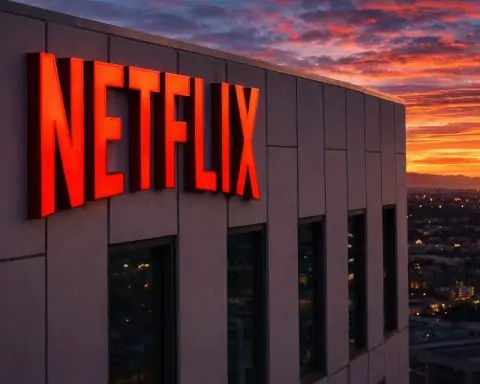- Price plunge: NFLX stock closed around $1,238 on Oct. 21 (near all-time highs) and was up roughly 30–40% so far in 2025 [1] [2]. After Netflix reported Q3 results on Oct. 21, shares fell about 5.6% in after-hours trading (to roughly $1,171) [3].
- Q3 results: Netflix posted roughly $11.5 billion in revenue for Q3 (≈+17% YoY) and net income ~$2.5B (EPS $5.87) – below Wall Street’s expected ~$3.0B ($6.97 EPS) [4]. The shortfall was largely blamed on a one-time $619 million Brazilian tax charge that hit profits [5]. (Excluding this, Netflix said its operating margin would have topped its 31.5% guidance.)
- Q4 guidance: Despite the miss, Netflix said it saw “good momentum” into year-end [6]. For Q4, it guided to about $11.96B revenue and $5.45 EPS (roughly 1¢ above consensus) [7]. The company also touted its “best ad sales quarter in history” in Q3 [8].
- Subscribers & content: Netflix now boasts ≈300 million paid subscribers globally [9]. Growth has been bolstered by cracking down on account sharing and a cheaper ad-supported tier (now ~94 million active viewers) [10]. Hit programming drove engagement: for example, the new animated film “K-Pop: Demon Hunters” became Netflix’s most-watched movie ever in Q3 [11]. (Netflix will also debut Stranger Things Season 5 in Q4 and even stream two NFL games on Christmas Day as it expands into sports [12] [13].)
- Analyst outlook: The Street remains mostly bullish. About two-thirds of analysts rate NFLX a “Buy,” with consensus 12-month targets around $1,330–$1,350 (implying ~10–15% upside) [14]. Some forecasters are even higher (Wedbush sees ~$1,500), though others are cautious. For example, JPMorgan recently cut its target to $1,275 (Neutral rating) despite calling Q3 “solid overall” [15]. Netflix’s valuation is steep (~45× forward EPS), and competitors like Disney+, Amazon Prime Video, YouTube/TikTok and regional services are aggressively expanding [16] [17].
Stock Performance and Recent Movement
Netflix’s stock had been on a tear in 2025. By mid-October, NFLX was trading near $1,240, roughly 30–40% higher than its level a year earlier [18] [19]. This rally reflected strong subscriber and revenue growth earlier in the year. As one Investopedia analysis noted, Netflix was expected to benefit from higher pricing, hit original shows and its growing ad business [20]. Year-to-date, Netflix’s gain has far outpaced the S&P 500.
However, that momentum wobbled on Oct. 21. After the markets closed, Netflix’s Q3 report fell slightly short of forecasts. In extended trading, NFLX shares tumbled about 5.6% to roughly $1,171 [21]. For context, the stock had closed the regular session around $1,238 on Tuesday [22]. The sell-off erased some of the recent gains but left Netflix still near multi-year highs. One analyst noted that Netflix had “risen 39% this year ahead of the earnings release,” so the post-earnings drop was a sharp reversal of that trend [23].
Q3 Earnings and Financial Results
Netflix’s third-quarter (July–Sept) results reinforced its revenue growth story but showed a profit stumble. The company reported about $11.5 billion in revenue (up ≈17% from a year ago) [24]. This roughly matched Wall Street forecasts, reflecting continued member growth and higher pricing globally. But earnings per share of $5.87 missed analysts’ expectations (around $6.97) [25]. Netflix attributed most of the shortfall to a one-time $619 million tax charge in Brazil, which knocked down operating profit. The company said this drag was an “unforeseen expense” and would not have a material future impact [26]. Indeed, Netflix noted that without the charge, its operating margin would have topped 31.5% (versus the reported 28%) [27].
Several positive signs came through in the quarter. Netflix highlighted that it achieved its “best ad sales quarter in history” in Q3 [28], and its global subscriber tally now exceeds 300 million [29]. The company reaffirmed its full-year targets – aiming for roughly $44–45 billion in revenue and ~30% operating margin in 2025. In its shareholder letter, Netflix said it was “finishing the year with good momentum” thanks to strong pricing and content investments [30]. For Q4, Netflix guided to about $11.96 billion in revenue and $5.45 in EPS [31] – slightly ahead of analyst projections.
Analyst Commentary and Outlook
Wall Street analysts have mixed but generally positive takes. Many point out that Netflix’s core business remains healthy. Bank of America analysts wrote that “Netflix shares will be fueled by continued positive subscriber and earnings momentum” along with new advertising and live opportunities [32]. PP Foresight’s Paolo Pescatore called Netflix’s report “another robust quarter, despite a blip due to an unforeseen expense” [33]. He noted the tax charge was an outlier. The co-CEOs also downplayed competitive threats, with Ted Sarandos saying Netflix can “be choosy” and isn’t forced to make any big acquisitions to hit its goals [34].
Price targets suggest more upside over the next year. Most brokerage forecasts cluster around the mid-$1,300s. For example, TS2.Tech reports that about 23 analysts have “Buy” ratings on NFLX, with average targets near $1,330–$1,340 [35]. Bernstein and Evercore see a high-$1,300s price range, and Wedbush even published a $1,500 target on the theory that Netflix could pursue big content deals [36] [37]. Conversely, some firms are more cautious. JPMorgan just trimmed its 12-month target from $1,300 to $1,275, calling the quarter “solid overall” but lacking the huge beats of prior quarters [38].
On subscribers, Wall Street largely expects continued growth. (Netflix no longer discloses net-adds routinely, but the consensus is that Q3 saw millions of new members, especially from price hikes and converting password-sharers.) One survey cited about 7 million net adds in Q3 [39]. Analysts believe Netflix’s scale – now about 302 million subscribers worldwide [40] – and its investments will keep churn low. Bank of America says Netflix’s size should protect it “in the near to mid-term” against consolidation in the media sector.
Competition and Industry Context
Netflix remains the industry leader, but the streaming business is fiercely competitive. Netflix far exceeds any single rival (Disney+ has ~126M subs, Amazon Prime Video a similar total) [41]. In the U.S., Netflix commands roughly a quarter of streaming viewership [42], although competitors are quickly matching its moves. For instance, Disney+ and HBO Max both raised prices in October [43], and Amazon is beefing up Prime Video with live sports and ads [44]. Social platforms are also nipping at Netflix’s heels: YouTube, TikTok and local services like Disney+ Hotstar are attracting younger viewers [45].
To differentiate, Netflix has broadened its offerings. It is pushing into new ad partnerships (e.g. co-marketing deals with brewer AB InBev tied to Netflix hits) and even live events [46] [47]. It will air NFL games and the Women’s World Cup in 2025, blurring the line with sports broadcasters. Analysts say these moves – along with its strong content lineup – justify Netflix’s hefty valuation for now. But they warn that at around 45× forward earnings, any slowdown or misstep could trigger more volatility. As eMarketer observes, current growth is still “predominantly [coming] from subscription fees”, underscoring how reliant Netflix is on core streaming revenue [48].
Outlook: Despite Tuesday’s sell-off, many experts see Netflix as a long-term winner. The company’s scale, global reach and aggressive growth initiatives give it an edge. As UBS analysts put it, Netflix remains a “secular winner” that should grow memberships and revenue over time [49]. But the near-term stock path will depend on whether Netflix can prove it can sustain subscriber momentum and profit growth in an increasingly crowded market.
Sources: Authoritative financial filings and news reports [50] [51] [52] [53], as well as analyst commentaries [54] [55] and industry data [56] [57].
References
1. www.investopedia.com, 2. www.investing.com, 3. www.reuters.com, 4. www.reuters.com, 5. www.reuters.com, 6. www.reuters.com, 7. www.reuters.com, 8. www.reuters.com, 9. ts2.tech, 10. ts2.tech, 11. www.reuters.com, 12. www.reuters.com, 13. ts2.tech, 14. ts2.tech, 15. www.investing.com, 16. ts2.tech, 17. ts2.tech, 18. www.investopedia.com, 19. www.investing.com, 20. www.investopedia.com, 21. www.reuters.com, 22. www.investing.com, 23. www.reuters.com, 24. www.reuters.com, 25. www.reuters.com, 26. www.reuters.com, 27. www.reuters.com, 28. www.reuters.com, 29. ts2.tech, 30. www.reuters.com, 31. www.reuters.com, 32. www.investopedia.com, 33. www.reuters.com, 34. www.reuters.com, 35. ts2.tech, 36. ts2.tech, 37. ts2.tech, 38. www.investing.com, 39. ts2.tech, 40. ts2.tech, 41. ts2.tech, 42. ts2.tech, 43. ts2.tech, 44. ts2.tech, 45. ts2.tech, 46. ts2.tech, 47. ts2.tech, 48. www.reuters.com, 49. www.investopedia.com, 50. www.reuters.com, 51. www.reuters.com, 52. ts2.tech, 53. ts2.tech, 54. www.investopedia.com, 55. www.investing.com, 56. ts2.tech, 57. ts2.tech







